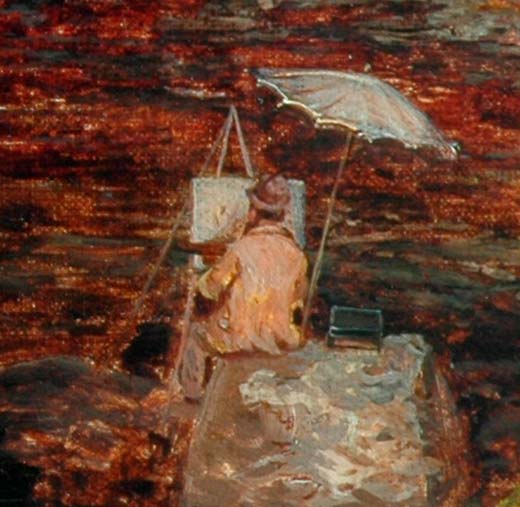Tuesday, 17 January 2023
Hebden Bridge Local History Society
A Victorian Artist paints the Upper Calder Valley: discovering the landscape paintings of John Holland
Speakers: Diana Monahan and Justine Wyatt
As Justine Wyatt explained to Hebden Bridge Local History Society, John Holland was not a prominent artist and very little has been written about him, but he was prolific and successful, not least during the time he spent painting the landscapes of the Calder Valley in the 1860s.

Justine and her fellow researcher, Diana Monahan, have been drawn to discover more about the artist and his career since they first looked closely at his painting of Hebden Bridge from the viewpoint of Palace House Road, which captured the town at a time of rapid expansion. Following a trail of local newspaper reports, sale catalogues and searching out some of the paintings held in regional collections, they have begun to fill in the gaps in his story.
John Holland was born in Nottingham in 1829, into a family of painters and picture framers, and he learnt his craft by copying pictures in his father's workshop. From the beginning, he felt the need to 'go to nature' – to paint in the open air – something made more possible by the invention of metal paint tubes.
The need to establish himself as an artist meant he gravitated to London, and exhibited paintings in the Royal Academy and the British Institution. In 1867, he was 'induced' to travel to the Calder Valley – perhaps by contacts such as the Fieldens, and the possibility of local patrons; certainly by the romantic landscapes which also carried the marks of an increasingly prosperous area.
Holland worked quickly (his paintings were dismissed as 'mere daubs' by one critic) and often depicted himself at his easel as a small figure in the landscape. His local patrons must have been delighted to see their town represented in such colour and magnificence, and proud of the signs of progress Holland captured – from the newly installed telegraph poles near Brearley to the gleaming new Dobroyd Castle and Unitarian Church in Todmorden.
Holland was not alone in being attracted to the Calder Valley's scenery – the archives reveal tourist brochures praising the beauty of the place. He was able to tap into this popularity, holding exhibitions and sales of his paintings. Despite a charge of 6d to enter the sale at the White Horse Hotel in Hebden Bridge, on one day 500 visitors were recorded.
His paintings were purchased in bulk by eminent local families – the Fieldens, Greenwoods, Sutcliffes and Shackletons, for example.
A report in the Hebden Bridge press – claiming Holland as 'our painter.. now a household name'– shows he was also getting commissions. A view of Ewood Hall was probably commissioned by the owner. Almost certainly a view of Cragg Valley from Ewood Hall was such a commission. Inspection with a magnifying glass revealed that a pair of sheep in the foreground bore the brand TR – an acknowledgment of his patron Thomas Riley, owner of the property.
Holland's paintings are not confined to the Calder Valley – a search of sites such as Art UK reveals paintings of various places in Yorkshire and further afield. He returned to London, then moved on to Cornwall adding romantic castles and sea scenes to his work. He also travelled to Italy, and probably to Norway. The Nottingham Gazette recorded that he was so popular that he struggled to complete his commissioned work, and stopped exhibiting in public, reducing his chances of being elected to the Royal Academy. Described as a genial man with many friends, his sociability may have contributed to his ill health and early death at the age of 55.
Holland's paintings of the Calder Valley are full of colour and detail, often peopled and with animals in the fields. The stone of the newly built halls and factories glows, and the smoke from the chimneys does not cast a pall over the scene. The waterfalls sparkle in the dramatic cloughs and people fish in the streams.
Diana's researches show that there was not much artistic licence – the scenes are topographically accurate, and the tiny details fill them with life. Through the power of the computer, we were able to take two delightful virtual journeys – the first by train to long-closed stations which Holland would have used to access his viewpoints in the valley. The second follows the path in Holland's scene of Brearley from Lower Ewood. The landscape is lovely, but it is the detail that makes it such a treasure for anyone looking to imagine life in the valley at the end of the nineteenth century.
We can follow paths that still exist, passing through a gap in the wall, and sharing the space with picnickers and locals. The road is lined with new telegraph poles, the cottages, halls, farms, inns, mills and chapels are recognisable in the detail of the painting. On the canal there is a horse-drawn boat, and the tenters are visible in a field.
Holland's obituary in the Hebden Bridge newspaper referenced how he led his life with many friends 'entwined around him' who 'enjoyed pleasant and agreeable hours'. The signs of humanity in his paintings seem to confirm this.
Calderdale's collection of Holland paintings of the area are currently on show at Bankfield Museum.
The next talk to Hebden Bridge Local History Society is at 7.30 on Wednesday 25th January at Hebden Royd Methodist Church. Peter Thornborrow will be sharing his knowledge of the 17th century yeoman farmhouses and oak furniture of the Upper Calder Valley. All welcome.
Details of the History Society talks programme, publications and of archive opening times are available on the History website and you can also follow History Society Facebook page.
With thanks to Sheila Graham for this report
See also: the HebWeb History section

